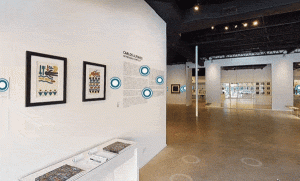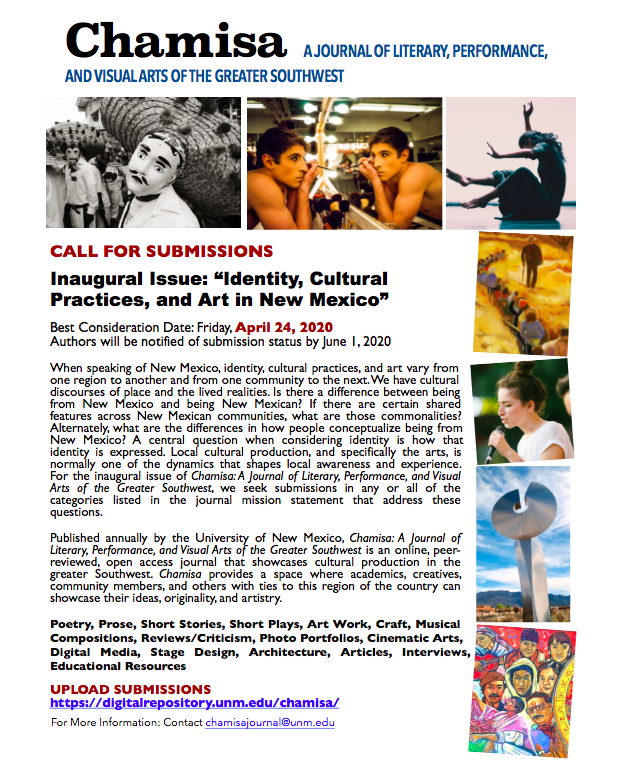Wednesday, Feb. 10
After the Hurricane: Art, Race, and Climate Change in the Modern Caribbean
Joseph R. Hartman, University of Missouri – Kansas City, part of the Bodies in Crisis 1 Session
Wednesday, February 10, 2021, 10-10:30 EST
Session Link: https://caa.confex.com/caa/2021/meetingapp.cgi/Session/8377
Down to Earth: Womxn Artists and Ecological Practices in Latin America
Chair: Madeline Murphy Turner, The Institute of Fine Arts, NYU
Wednesday, February 10, 2021, 10-10:30 EST
Session Link: https://caa.confex.com/caa/2021/meetingapp.cgi/Session/7556
Papers:
- Carlota Di Liscia, Blood, Spit, and Tears: Performing Gender and Ethnicity in Sandra Monterroso’s “Lix Cua Rahro/Tus tortillas, mi amor”
- Florencia San Martin, Inhabiting the Waters: The Art of Mapuche Artist Sebastián Calfuqueo
- Gillian Sneed, Opossum Resilience and Dry Twigs: Ecofeminist Cuir Camp in Contemporary Latin American Video Performance
- Madison C. Treece, Embroidering Politics: Maya Cosmologies Influence in “Zapantera Negra”
Love in times of crisis: Reparative Art Histories
Wednesday, February 10, 2021, 2:00-2:30 PM
Session Link: https://caa.confex.com/caa/2021/meetingapp.cgi/Session/7989
ALAA-Relevant papers:
- Mya Dosch: “Signs of Life: Teatro Ojo against Spectacular 1968 in Mexico”
Thursday, Feb. 11
Georgina G. Gluzman: “Home Is Where the Heart Is”: Foreign Women Artists in Argentine Art History” (paper), part of the session CAA-Getty Global Conversation I: The Migration of Art and Ideas (chair: Georgina G. Gluzman)
Thursday, February 11, 2021, 10-10:30 EST
Session link: https://caa.confex.com/caa/2021/meetingapp.cgi/Session/7586
Nourish and Resist: Food and Transatlantic Feminisms in Contemporary Caribbean Art
Co-chairs: Hannah Ryan and Lesley A. Wolff
Thursday, February 11, 12-12:30PM EST
Papers:
-Shana Klein, “Pulling Back the Peel: Exploring the Unsavory History of the United Fruit Banana in Contemporary Art”
-Tashima Thomas, “Botanical Feminisms: From Ethnogenesis to Edible Desire”
-Maria Elena Ortiz, “Food Markets and Power”
-Cristina Molina and Vanessa Centeno, “Forbidden Foods”
Session link: https://caa.confex.com/caa/2021/meetingapp.cgi/Session/7152
How Exhibitions and Collections Have Shaped the History of Art of Brazil
Chairs: Paulina Pardo Gaviria; Paula Victoria Kupfer, University of Pittsburgh
Discussant: Elena Shtromberg, University of Utah
Thursday, February 11, 12-12:30PM EST
Papers:
-Fernanda Mendonca Pitta, “An Ancient New World: The 1889 Universal Exhibition in Paris and “the Birth” of Brazilian Indigenous Art”
-Camilla Querin, “Revolutionary Popular Art: How Two Centers for the Promotion and Production of Popular Art Shaped the Development of Contemporary Art in Brazil”
-Sonia Angela de Laforcade, “Between the Exhibition and the Courtroom”
-Mari Rodriguez Binnie, “On Vertices and Ruptures: The 1977 Projeto Construtivo Brasileiro na Arte”
Session link: https://caa.confex.com/caa/2021/meetingapp.cgi/Session/7903
Creative Cartographies & Inherited Aesthetics: Craft, Tradition, and Labor in Modern and Contemporary Fine Art Practices
Thursday, February 11, 6:00-6:30 pm EST
Chair: Erin L. McCutcheon
Discussant: Ella S. Mills
Papers:
- Karen Cordero, “Revaluing Feminine Trajectories and Stitching Alternative Genealogies in the Work of Yohanna Roa”
- Imogen Hart, “Althea McNish: Designs Without Borders”
- Penny C. Morrill, “Matilde Poulat: Discovering Her Nahua Past in Silver”
- Tatiana Reinoza, “Racial Performance and the Maternal: Restaging Central America in Rachelle Mozman’s Photographs”
Session Link: https://caa.confex.com/caa/2021/meetingapp.cgi/Session/7819
Towards the “Concrete Transaction”: Global Methods for Art in Capital
Chairs: Avigail Moss and Ellen C. Feiss
Thursday, February 11, 12-12:30PM EST
-Uneven and Combined Development, Art History, and Concrete Totality
- Ciaran Finlayson
- -Berni: Art and Hegemony
- Karen Benezra
- -From Democratic Pluralism to Corporate Hegemony: US Art after 1943
- Angela L. Miller, Washington University in St. Louis
- -Racial and Economic Inequality: the SFMOMA and the Private Fisher Collection
- Nizan Shaked, California State University, Long Beach
Session Link: https://caa.confex.com/caa/2021/meetingapp.cgi/Session/7187
Friday, Feb. 12
Peru’s Bicentenary: Identity Fractures in a Period of Transition from the colonial to the Republican Era
Friday, February 12, 10:00 – 10:30 am EST
Chairs: Verónica Muñoz-Nájar and Katherine Moore McAllen
Discussant: Natalia Majluf
Papers:
- Elena Phipps, Andean Seventeenth-Century Black Uncus worn for Corpus Christi and the Left-spun yarn that Empowers them.
- Leslie Todd, Confronting Racialized Narratives of Sculptural Production and Consumption in Eighteenth-Century Quito.
- Grace Alexandrino Ocaña, Migrants, Murals and Metropolitan Identities: Public Spaces and Urban Heritage Aesthetics as Struggles for Historic Lima.
Session link: https://caa.confex.com/caa/2021/meetingapp.cgi/Session/7974
How Exhibitions and Collections Have Shaped the History of Art of Brazil
Chairs: Paula V. Kupfer (University of Pittsburgh) and Paulina Pardo
Discussant: Elena Sthromberg (University of Utah)
Thursday February 11, 12pm–12:30pm EST
- – Fernanda Mendonca Pitta, “An Ancient New World: The 1889 Universal Exhibition in Paris and ‘the Birth’ of Brazilian Indigenous Art”
- – Camilla Querin (University of California, Riverside), “Revolutionary Popular Art: How Two Centers for the Promotion and Production of Popular Art Shaped the Development of Contemporary Art in Brazil”
– Sonia Angela de Laforcade, “Between the Exhibition and the Courtroom”
– Maria Teresa Rodriguez Binnie (Williams College), “On Vertices and Ruptures: The 1977 Projeto Construtivo Brasileiro na Arte”
Arts of the Screen in Latin America, 1968-1990
Friday, February 12, 4:00 – 4:30 pm EST
Chairs: Daniel Quiles and Benjamin Murphy
Papers:
-Paulina Pardo Gaviria, “Lent for Exhibition Only: TV Screens at the São Paulo Biennial”
-William Henry Schwaller, “Argentina Intermedios: A two-night show and a fitting descriptor of Buenos Aires at the turn of the 1970s”
-Dorota Biczel, “From Screen to Shroud: Burying the Criollo Republic with Juan Javier Salazar”
-Agustin Diez Fischer, “Out of the Human and into the Screen: Leopoldo Maler and Television in the 1970s”
Session link: https://caa.confex.com/caa/2021/meetingapp.cgi/Session/7646
Revisting the Popular in Latin American Art
Friday, February 12, 6:00 – 6:30pm EST
Chair: Megan Sullivan
Discussant: Ana María Reyes
Davida Fernandez-Barkan, “Arte Popular’s International Legacy: The Case of Mexican Muralism”
Laura Moure Cecchini, “‘Artists Must Live with their Eyes Open: Antonio Berni, The Andean Baroque, and Latin American Popular Art”
Harper Montgomery, “The Liberation and Development of Popular Art: A Modernist
Polemic for El Museo del Barro”
Cristobal Barria Bignotti, “The Sense of Touch in the Apprehension of Popular Art”
Saturday, Feb. 13
Architectural Sculpture in the Ancient and Early Modern Periods
12:00 am – 12:30 am EST
Chairs: Gretel Rodriguez and Meghan Rubenstein
Patricia Alexander Lagarde, Tulane University “Sculpting with the Sun: Phenomenology of Light in Architectural Sculpture at Chavín de Huántar, Peru”
Breton Adam Langendorfer, University of Pennsylvania, “Achaemenid Syntax: Architecture, Metalware, and Imperial Modularity”
Aileen Ajootian, University of Mississippi, “Roman Architectural Sculpture at Ancient Corinth: New Discoveries”
Gregor A. Kalas, University of Tennessee, “Repossessing the Sculptures on the Arcus Argentariorum in Early Medieval Rome”







